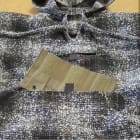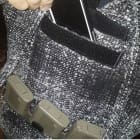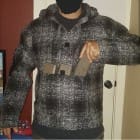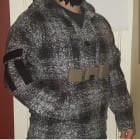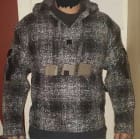The first mention of combat swimmers appears in the chronicles of the Greek historian Herodotus ca 450BC. The Persian king Xerxes used divers to retrieve goods off of sunken ships. They were also used for ship repair and reconnaissance of harbors and channels.
Almost every Navy throughout history has had some form of combat swimmers. They have been used to smuggle goods in during the siege of Syracuse during the Peloponnesian war. The Spartans and Athenians were one of the first to employ combat swimmers, but history usually credits Alexander the Great in his famous siege of Tyre (Lebanon) in 332 B.C. He used “demolition divers” to remove obstacles from the harbor. Aristotle reported that Alexander himself made several dives in a crude diving bell to observe the work in progress. They were also used to cut the anchor lines of Roman ships by the Byzantines in 320 BC. The Byzantines replaced the lines with their own and pulled the Roman boats into the harbor ending a 3-year siege. The Romans then replaced all their anchor line with steel chains.
The U.S. started using Combat swimmer at the birth of our country. They were used during the revolutionary war to set fires and sink British ships. They were also used in the Civil war by both sides for sabotages and scouting. The U.S. didn’t really use combat swimmers again until WW2. Although some Americans did service with specified dive units of our allies in WW1. Those men would go on to help set up the units we used in WW2.
The combat diving mission was the same in World War II as it had been in previous wars: to remove obstacles from enemy waters and to gather intelligence. The Navy’s Underwater Demolition Teams (UDT) were created from bomb disposal experts and SeaBees (combat engineers) teamed together in 1943 to devise methods for removing obstacles that the Germans were placing off the beaches of France.
There where more than one combat swimmer/diver unit for the U.S. Navy in WW2. To name a few where the Navy Scouts and Raiders unit, Underwater Demolition Units (UDT), Navy Combat Demolitions Units (NCDU) and the OSS Maritime Unit. The OSS MU was on the cutting edge for U.S. combat swimmer/ divers. They where the first to use the Lambertsen Rebreathing Unit (LARU), an early underwater breathing device. The Lambertsen unit permitted a swimmer to remain underwater for several hours and to approach targets undetected because the LARU did not emit telltale air bubbles. Dr. Christian J. Lambertsen, then a U.S. Army captain, developed the Lambertsen for the MU. They also developed or used several innovative devices, including an inflatable surfboard, a two-man kayak, and limpet mines that attached to the hull of a ship.
The first UDT combat mission, wherein the Pacific. It was a daylight reconnaissance and demolition project off the beaches of Saipan in June 1944. In March of the next year, preparing for the invasion of Okinawa, one underwater demolition team achieved the exceptional record of removing 1,200 underwater obstacles in two days, under heavy fire, without a single casualty.
Diving apparatus where not extensively used by the UDT during the war. No suitable equipment was readily available to them. UDT experimented with a modified Momsen lung and other types of breathing apparatus, but not until 1947 did the Navy’s acquisition of Aqua-Lung equipment give impetus to the diving aspect of UDT operations. The trail of bubbles from the open-circuit apparatus limited the type of mission in which it could be employed, but a unique SCUBA (self-contained underwater breathing apparatus) platoon of UDT members was formed to test the equipment and determine appropriate uses for it.
UDT-21 (now SEAL Team 4) is credited with accepting the first official surrender on mainland Japan of WW2. Here the Commanding Officer LTCmdr Clayton of UDT-21 receives the first sword surrendered to the U.S. on mainland Japan. When he returned to the ship, he was ordered to return it so they could surrender to General MacArthur (just one more thing in a long list, that makes him one of the worst generals in history.)

At the end of WW2, most of the special maritime units where dissolved, all except a hand full of UDT teams. In the Korean Conflict, the Frogman started to come out of the water more and more. They where assigned targets like destroying bridges and other direct action missions.
In 1962, President Kennedy established SEAL Teams ONE and TWO from the existing UDT Teams to develop the Navy’s Unconventional Warfare capability. The Navy SEAL Teams were designed as the maritime counterpart to the Army Special Forces “Green Berets” with their primary focus on Direct Action missions. They deployed immediately to Vietnam to operate in the deltas and thousands of rivers and canals in Vietnam and effectively disrupted the enemy’s maritime lines of communication.
The SEAL Teams’ mission was to conduct counter guerilla warfare and clandestine maritime operations. SEALs also advised and trained Vietnamese forces, such as the LDNN (Vietnamese SEALs). Later in the war, SEALs conducted nighttime Direct Action missions such as ambushes and raids to capture prisoners of high intelligence value.
The SEALs were so effective, that the enemy named them, “the men with the green faces.” At the height of the war, eight SEAL platoons were in Vietnam on a continuing rotational basis. The last SEAL platoon departed Vietnam in 1971, and the last SEAL advisor in 1973.
In 1983 all UDT teams where turned into SEAL teams (SEAL Team 4 and 5) and SEAL Delivery teams (SDV 1 and 2). All branches of service have Combat Swimmer/Divers. In the Army, Rangers and Special Forces (Green Berets) can go thru Army combat diver school in Key West. The Air Force has a combat diver course for all ParaRescue and Combat Controllers. As both groups get assigned to work with all branches of Special Forces, they have to know how to dive as well. The Marines also have a Combat dive course that Marine Raiders and Recon personal attend.
Explosive Ordnance Disposal units. All branches also have EOD units. They are as old as the combat swimmer unit and have always been a big part of every military operation. Draper Laurence Kauffman, the man credited with starting the UDT, and being the first U.S. frogman was first an EOD officer with the British at the start of WW2. One month before Pearl Harbor he returned to the U.S. and joined the Naval Reserve. EOD personnel are some of the smartest people on the battlefield today. They are right there in the fight with all Special Forces and conventional units.
The mission of the combat swimmer has not changed much since it started around 450 BC. Combat swimmers still conduct special reconnaissance missions of beaches and harbors. They can climb out of the water to destroy something or even grab someone off a beach. The only thing that has changed is the technology that is available to them, but the basic combat swimmer skills will always be the same. Just about every country in the world is accessible from the water so the need for a combat swimmer will never go away.








